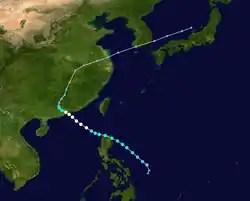Tropical Storm Sam (1999)
Severe Tropical Storm Sam, also known in the Philippines as Luding was a storm that formed on August 1999.
| Severe tropical storm (JMA scale) | |
|---|---|
| Category 1 typhoon (SSHWS) | |
 Sam (August 22) | |
| Formed | August 17, 1999 |
| Dissipated | August 24, 1999 |
| Highest winds | 10-minute sustained: 100 km/h (65 mph) 1-minute sustained: 140 km/h (85 mph) |
| Lowest pressure | 980 hPa (mbar); 28.94 inHg |
| Fatalities | 20 total |
| Damage | $35 million (1999 USD) |
| Areas affected | Philippines, South China |
| Part of the 1999 Pacific typhoon season | |
Meteorological history

On August 17, an area of circulation within the monsoon trough located in the Philippine Sea became more organized and the JTWC issued a TCFA. The developing cyclone slowly moved to the northwest, becoming Tropical Depression 16W nine hours after the TCFA was first issued. As the cyclone continued to intensify, it became Tropical Storm Sam on August 19. Around this time, the subtropical ridge to Sam's north shifted its track in a westwards direction towards Luzon. The storm passed over the north of the island on August 20 and entered the South China Sea reaching typhoon strength the next day. Sam gradually intensified further as it approached the Chinese coast and it made landfall about 19 km (12 mi) to the northeast of Hong Kong at its peak with 140 km/h (85 mph) winds on August 22. Sam continued to move to the northwest over China dissipating about 24 hours later.[1] PAGASA named the developing storm Luding shortly before the JTWC began to issue advisories.[2]
Impact
Typhoon Sam was responsible for seven deaths in the Philippines.[3] In addition, flooding from its rainfall displaced over 4000 people, and many major roads were closed due to landslides near Baguio.[4] Sam became the wettest tropical cyclone to affect Hong Kong since records began in 1884, dropping over 616 mm (24.2 inches) of rain, exceeding the previous record set in 1926. Peak sustained winds of 96 km/h (60 mph) were recorded on Waglan Island as the typhoon passed over the territory. The heavy rain led to many instances of flooding and over 150 landslides throughout Hong Kong, killing 1 person and forcing the evacuation of about 1,000. A total of 328 people were injured in various incidents relating to the storm, and total losses in Hong Kong totaled to approximately $17 million.[5] In addition to the direct casualties from the storm, China Airlines Flight 642, using an MD-11 aircraft, crashed while attempting to land at Hong Kong International Airport, killing three on board and injuring 219. At the time of the crash wind gusts in excess of 65 km/h (40 mph) were recorded at the airport.[6] After moving into China, Sam killed at least 17[3] and injured 100 people in Guangdong. Direct economic losses in the province were about $18 million.[5]
References
- Joint Typhoon Warning Center. "Typhoon Sam (16W)" (PDF). 1999 Annual Tropical Cyclone Report. p. 76. Retrieved August 19, 2013.
- Padgett, Gary. "Monthly Global Tropical Cyclone Summary: August 1999". Archived from the original on March 23, 2007. Retrieved February 17, 2007.
- Joint Typhoon Warning Center. "Typhoon Sam (16W)" (PDF). 1999 Annual Tropical Cyclone Report. p. 76. Retrieved August 19, 2013.
- Padgett, Gary. "Monthly Global Tropical Cyclone Summary: August 1999". Archived from the original on March 23, 2007. Retrieved February 17, 2007.
- Hong Kong Observatory (April 2000). "Typhoon Sam (9910)" (PDF). Tropical cyclones in 1999. pp. 56–66. Archived from the original (PDF) on May 24, 2011. Retrieved February 17, 2007.
- Civil Aviation Department, Hong Kong (December 2004). "Aircraft Accident Report 1/2004" (PDF). Retrieved February 17, 2007.

